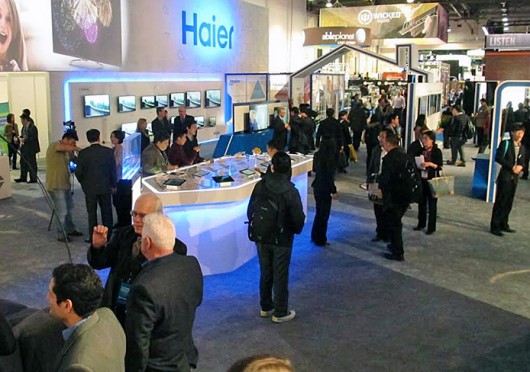
Six OSU students and 3 instructors went to Las Vegas to work at the Consumer Electronics Show in early January. Their trip was funded by Chinese appliance company Haier.
Credit: Courtesy of Amanda Amsel
While a Chinese company and council each recently invested thousands of dollars in Ohio State graduate students, some prospective students are losing an opportunity to participate in a master’s degree program because of a lack of scholarship funding from within the U.S., a director of the OSU program said.
In July, the flagship program’s website announced seven OSU Chinese flagship graduate students had been awarded full scholarships by the China Scholarship Council to study at Chinese universities for the 2013-14 academic year.
Meanwhile, though, none of the six graduate students currently studying at OSU through the flagship program are being provided any scholarships, Galal Walker, professor of Chinese in the Department of East Asian Languages and Literatures and director of the Midwest U.S.–China Flagship program, said.
“Not everyone can self-fund for this kind of program,” Walker said. “We’ve had to tell some people that would be very good, that we’d really like to have, that we don’t have the funding for them.”
The OSU Midwest U.S.-China Flagship program is a two year master’s program for students to become more proficient at Mandarin Chinese, according to its website.
The program costs about $11,300 for in-state students and about $28,700 for out-of-state students, according to its website.
Many American businesses do not see the need to fund scholarships for Americans who want to learn Chinese when some Chinese people can speak English, Walker said.
“Sometimes rather than our students working for American companies, they will be working for Chinese companies,” Walker said. “The Chinese are internationalizing and they see the value of people who are conversant and adaptable to both cultures.”
Recently, the six students currently studying at OSU through the program had the opportunity to sharpen their skills because of a Chinese company’s funding.
Chinese appliance company Haier paid between $30,000 and $40,000 for six graduate students and three instructors in the OSU Midwest U.S.-China Flagship program to work at the Consumer Electronics Show in Las Vegas Jan. 7, Walker said.
The CES is an annual trade show for manufacturers, developers and technology hardware suppliers to network and attended conference programs, according to its website.
The students were in charge of bringing in an audience for Haier’s presentation of a new air conditioning concept. The students and instructors flew out Jan. 6, attended the trade show Jan. 7 and flew home Jan. 8, Walker said, and Haier paid for everything.
The goal of the flagship project is to bring students up to the level of language and culture so that they can interact with the Chinese successfully and comfortably, Walker said.
Students were able to showcase some of the skills they learned through the flagship program during their trip to the CES.
Briun Greene, a first-year graduate student in the OSU Midwest U.S.-China Flagship program, said he wasn’t sure what they would be doing for Haier at the trade show before they arrived.
The OSU graduate students were passing out fliers for Haier when there was an unexpected need for an interpreter. Greene said he volunteered, and after 10 minutes of preparation, he was interpreting for a group of about 30 people.
“That was something I will never forget. It was probably one of the coolest moments of my life,” Greene said.
Mack Lorden, a first-year graduate student in the OSU Midwest U.S.-China Flagship program, said he wasn’t nervous working at the trade show with all the practice he had accumulated through the flagship program.
Lorden plans to use his master’s degree to help bring Chinese culture to American shores.
“I think we get so fired up about America that we forget the rest of the world is out there and that it’s a wonderful place,” Lorden said.


